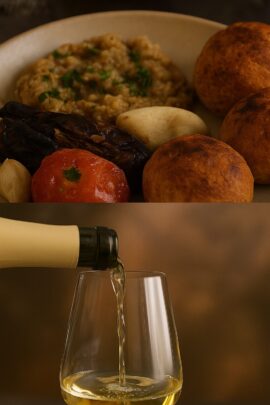Introduction
Bold, rustic, and deeply tied to the soil of Bihar, Litti Chokha is more than a dish—it’s a cultural symbol of resilience and simplicity. Traditionally eaten by farmers, this dish has now found a place in fine-dining kitchens and food festivals across India. But can this earthy, smoky, and spice-forward dish find harmony with wine? Absolutely—with the right understanding of flavors and chemistry.
Dish Name & Cultural Context
Litti Chokha originates from the Indian state of Bihar and is a staple in Bihari households. Litti is a dough ball stuffed with roasted gram flour (sattu), spices, and herbs, baked over coal or wood fire. Chokha is a mashed vegetable preparation, usually made from roasted eggplant (baingan), tomato, and boiled potatoes, all blended with mustard oil, green chilies, garlic, and onions. Together, they create a dish that’s smoky, spicy, hearty, and pungent.
Key Ingredients & Preparation Style
- Litti: Whole wheat dough, sattu (roasted chickpea flour), ajwain (carom seeds), garlic, ginger, mustard oil.
- Chokha: Roasted eggplant, boiled potatoes, tomatoes, raw garlic, green chilies, mustard oil.
- Traditionally cooked on open flame or charcoal for smokiness.
- Often served with ghee or yogurt on the side.
Flavor & Texture Profile
- Smoky: From fire-roasting the chokha vegetables and baking litti.
- Spicy & Pungent: Mustard oil, raw garlic, and green chilies dominate.
- Earthy & Nutty: Roasted gram flour stuffing adds depth.
- Hearty & Dense: Litti is heavy and dry unless paired with chokha or a drizzle of ghee.
Science Behind Spice & Wine Interactions
- Mustard oil contains allyl isothiocyanate, which intensifies the burn of alcohol—so low-alcohol wines work better.
- Raw garlic & chilies demand wines with fruitiness and a touch of sweetness to soothe heat.
- Roasted, earthy notes call for wines with good acidity to refresh the palate.
- Avoid: High tannin wines—they can clash with the spice and texture, making the wine seem bitter.
Ideal Wine Pairings: The Science & Art of Selection
White Wines
- Gewürztraminer (Alsace, France or Alto Adige, Italy)
- Why it Works: Aromatic, floral, low acidity, slightly sweet—perfect for mustard oil and garlic.
- Regions/Producers to Try: Domaine Weinbach (Alsace), Elena Walch (Alto Adige)
- Grüner Veltliner (Austria)
- Why it Works: Crisp acidity, white pepper notes complement spices. Cleanses palate without overpowering.
- Regions/Producers: Nikolaihof, Domäne Wachau
- Dry Furmint (Tokaj, Hungary)
- Why it Works: High acidity with flinty minerality and orchard fruit—balances spice and smoke beautifully.
- Regions/Producers: Oremus, Royal Tokaji
Red Wines
- Gamay (Beaujolais Villages, France)
- Why it Works: Low tannins, vibrant red fruit, and freshness tame spice and lift the dish’s rustic notes.
- Producers: Jean Foillard, Marcel Lapierre
- Zweigelt (Austria)
- Why it Works: Fruity, juicy, light-bodied red that doesn’t clash with mustard oil or heat.
- Producers: Umathum, Heinrich
- Pinot Noir (Romania or New Zealand)
- Why it Works: Subtle red fruit and earthy undertones echo roasted chokha flavors without overpowering.
- Producers: Cramele Recaș (Romania), Ata Rangi (NZ)
Alternate Wines: Unexpected Pairings
- Pet-Nat (Natural Sparkling Wines)
- Wild bubbles, low alcohol, funky earthiness—a quirky match for the smoky earth tones.
- Orange Wine (Skin-Contact Whites)
- Tannin-like grip and nutty texture mirror the sattu; great with garlic and mustard oil.
- Chilled Lambrusco (Italy)
- Fruity fizz, slight sweetness, and acid makes it a fun contrast to this rustic meal.
Wines to Avoid & Common Mistakes
| Mismatched Pairing | Why It Doesn’t Work | Better Alternative | Example Wine | Example Reason | Suggested Wine |
|---|---|---|---|---|---|
| Bold Cabernet Sauvignon | High tannins clash with spice and mustard oil | Low-tannin reds | Napa Cab | Too oaky, drying | Gamay or Zweigelt |
| Oaky Chardonnay | Overwhelms with buttery oak | Crisp aromatic white | California Chard | Fights mustard oil | Gewürztraminer |
| Sparkling Brut Nature | Too dry, sharp with garlic | Slightly off-dry styles | Brut Champagne | Harsh acidity | Demi-sec Vouvray |
Final Thoughts & Expert Tips
Pairing wine with Litti Chokha may seem unconventional, but with the right bottle, it becomes an enriching experience. The key is to honor the dish’s smoky, earthy roots and tame its pungency with fruit, freshness, and balance.
Fun Fact: In Bihar, litti was historically used as a travel food—durable, nutritious, and filling. Now it travels across cuisines, even onto your wine table.
Personal tip: I once served this dish with a chilled bottle of Austrian Grüner Veltliner at a backyard gathering. The wine’s peppery finish picked up the ajwain, while its zesty acidity cut right through the ghee. The pairing got more compliments than the dessert!
Recipe & Wine-Friendly Adjustments
Ingredients
For Litti
- Whole wheat flour
- Roasted sattu
- Garlic, ginger
- Ajwain
- Lemon juice
- Mustard oil
- Salt
For Chokha
- Roasted eggplant
- Boiled potatoes
- Tomatoes
- Green chilies
- Garlic
- Onions
- Mustard oil
- Fresh coriander
Preparation
- Mix wheat flour with water and oil to make stiff dough.
- For filling: mix sattu with mustard oil, garlic, ajwain, lemon juice, salt.
- Stuff balls of dough with filling and bake over coal or in an oven at high temp.
- Roast vegetables for chokha directly on flame.
- Mash all chokha ingredients with mustard oil, salt, chilies, garlic.
- Drizzle ghee over hot litti before serving.
Wine-Friendly Modifications
- Reduce chili slightly if serving wine.
- Mix in a little yogurt in chokha to soften pungency.
- Serve yogurt raita or cucumber salad on the side to bridge flavors.
Serving Suggestions
- Plate with 2–3 littis, a generous scoop of chokha, and a bowl of chilled yogurt.
- Garnish with fresh coriander and a drizzle of ghee.
- Serve with lightly chilled wine (white or red) in wide glasses.


